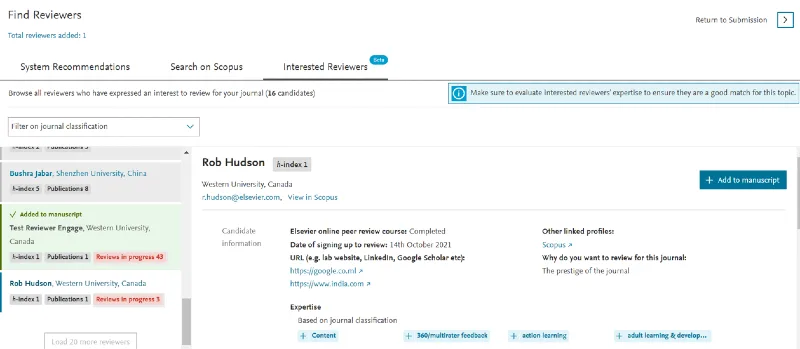Editors' Update - supporting editors, every step of the way.

Lamentablemente no somos totalmente compatibles con su navegador. Si tiene la opción, actualice a una versión más reciente o utilice Mozilla Firefox, Microsoft Edge, Google Chrome o Safari 14 o posterior. Si no puede y necesita ayuda, envíenos sus comentarios.
Agradeceríamos sus comentarios sobre esta nueva experiencia.Díganos qué piensa se abre en una nueva pestaña/ventana
22 de noviembre de 2021 | Lectura de 5 min
Por Katie Eve, José Stoop

© istockphoto.com/patpitchaya
This is the third in a series of “tips & tricks” articles on making the review process easier and quicker. This article focuses on optimizing your selection of reviewer candidates from the various sources available.
With the Find Reviewers tool now rolled out to nearly all Elsevier journals on Editorial Manager, editors have a wealth of reviewer candidates at their fingertips. It can be tempting, given the all-too-familiar difficulty of securing sufficient reviewers, to bulk-invite referees. Whilst this might seem on the surface to be a sensible tactic, it may result in overburdening the reviewer pool, and lead to increased declines.
You are therefore encouraged to carefully assess your candidate selection in the light of their research expertise and be as sparing as possible with issuing invitations. Luckily, the Find Reviewers tabs offer plenty of signals that will give you a good indication of each candidate’s match, such as their Scopus profile, h-index, matching publications, keywords or classifications, citation history, and their review history and current review workload both on your journal and also across all Elsevier journals. So, when you are ready to send your invitations, please take a step back and cautiously review your current selection to avoid inviting twelve mediocre matches for the paper rather than four excellent ones.
“Interested reviewers” are researchers who have indicated they are eager to review for your journal through the Volunteer to review option on Reviewer Hub se abre en una nueva pestaña/ventana. You will find these reviewers on the new “Interested Reviewers” tab on Find Reviewers.
If your journal has classifications, the interested reviewers will have selected these upon registering on Reviewer Hub, and you can filter on these when searching for them on Find Reviewers. Please note that if your journal does not have classifications in place, reviewer candidates are not matched by research expertise like the system recommendations and keyword search results are. This means that you will have to match them yourself with the available signals. The current signals include the match between the manuscript keywords and the candidates’ published articles, their citation statistics, their Scopus profile (this includes information about h-index, affiliation, publications and is mandatory upon registration) and the reviewer history across all Elsevier journals (reviews in progress, accepted invites).
Please treat your journal’s interested reviewers as a precious resource by inviting only the best-matching candidates (ideally not more than two) and always complement your invitation list with selections from the other reviewer resources.

The Find Reviewers tool - note the new "Interested Reviewers" tab
Coming soon: Corresponding authors whose manuscripts have been accepted across Elsevier journals in the last three months will be tagged on Find Reviewers. Our pilot data suggests these researchers also have a high willingness to review, and by highlighting them to editors they could be included in the reviewer pool.
We have recently written about the importance of inclusion & diversity in peer review. Ensuring peer review by individuals with diverse backgrounds protects against gaps, biases and blind spots, minimizes confirmation bias, promotes innovation and development, and ultimately leads to greater scientific rigor and more inclusive research.In addition, by broadening the reviewer pool you will spread the load across more reviewers ultimately leading to faster and more thorough reviews. Positive change can start small. It can be as simple as taking a minute to self-check and strive for balance as you issue your reviewer invites day-to-day. For example, if you approach a field leader with a high h-index who is likely to provide an established “big-picture” view, pair them with an early career reviewer. Consider diversity attributes such as: gender, career stage, affiliation & country, race & ethnicity, first language, etc. We have recently provided a series of best practice guidelines for editors for improving reviewer diversity, in a two-part article starting here.
Most journals ask authors to suggest potential reviewers. You can find these suggestions in the drop-down menu in the “Search my Publication” box, selecting “Suggested by author”. Since authors are not provided with enhanced search tools to identify relevant referees, they usually suggest individuals from their own network. These candidates might have potential conflicts of interest and/or confirmational biases. Several studies (e.g. here se abre en una nueva pestaña/ventana, here se abre en una nueva pestaña/ventana, and here se abre en una nueva pestaña/ventana) show that author-suggested reviewers are more likely to recommend “minor revision” or “accept”, for example.
More concerningly, there have also been cases of fraud with author-suggested reviewers; it is therefore critical to independently validate the email addresses of any suggestions. You can do this by matching the email address provided to an existing user in the journal’s database, by using the “Author Suggested Reviewer” flag in Find Reviewers (which verifies they have a Scopus account), or otherwise by independent internet search. When using author-suggested reviewers, you should always use at least one more independent referee who is ideally also diverse from the submission author(s).
Lastly, with so with so many rich reviewer candidate resources available to you, we generally advise to aim for a healthy balance of candidates found through the system recommendations / Scopus search, author-suggested reviewers, "interested reviewers", Editorial Board members and the journal’s own reviewer database. Be smart and draw your selection from across these tools.
We hope these tips will help you choose well-matched reviewers who are more likely to agree to review, and at the same time expand your reviewer pool. Let us know if you have any tips or recommendations of your own in the comments below!
System Recommendations – system-generated candidate recommendations based on an algorithm that takes various aspects into account
Search on Scopus – enables a keyword candidate search using Scopus data
Interested Reviewers (NEW!) – reviewer candidates who have indicated they are keen to review for the journal
